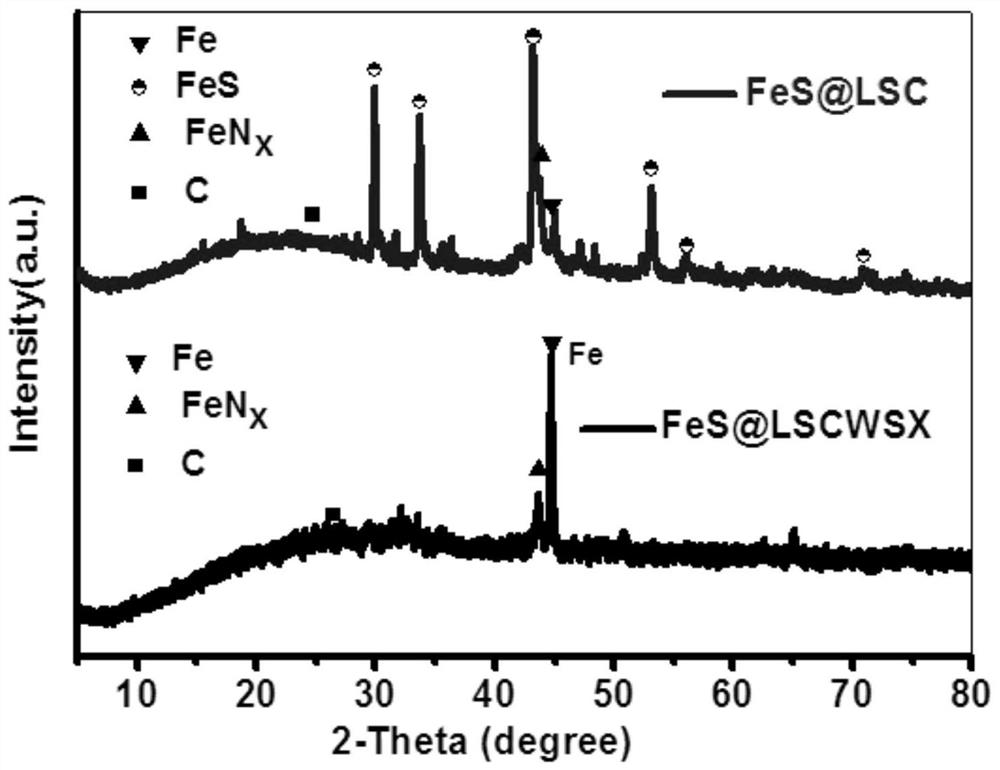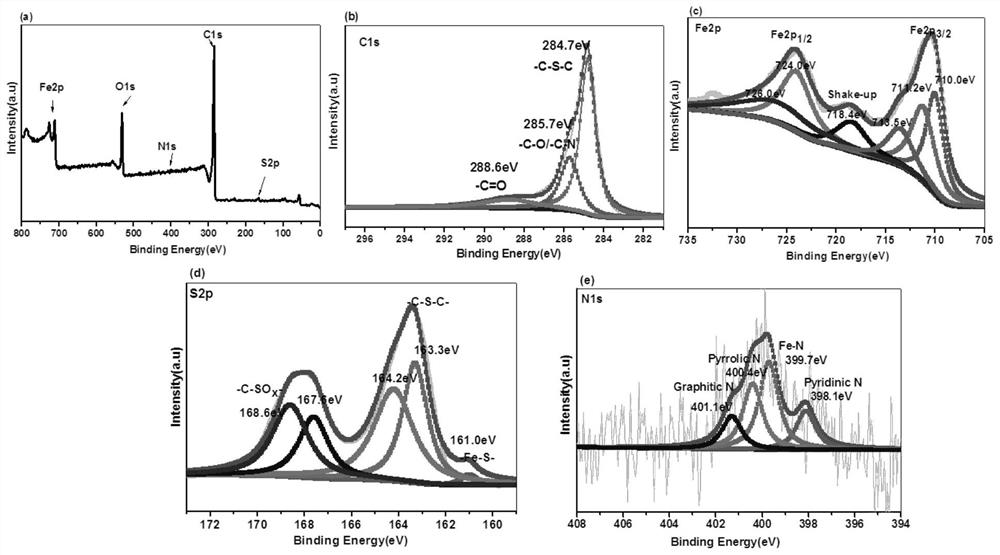Preparation method of monatomic catalyst for activating sulfite to degrade pollutants
A technology for activating sulfite and pollutants, which is applied in the direction of catalyst activation/preparation, physical/chemical process catalysts, water pollutants, etc., to achieve remarkable catalytic effect, simple and effective synthesis method, and high specific surface area
- Summary
- Abstract
- Description
- Claims
- Application Information
AI Technical Summary
Problems solved by technology
Method used
Image
Examples
Embodiment 1
[0029] A method for preparing a single-atom catalyst for activating sulfite to degrade pollutants, comprising the steps of:
[0030] (1) Pretreatment of raw materials: drying sodium lignosulfonate at a low temperature of 55°C for 2 hours for later use, then mixing sodium lignosulfonate and ferric nitrate in a ratio of 5:4;
[0031] (2) Mechanical ball milling: Add the above mixture into a mechanically activated solid-phase reactor, and carry out ball milling reaction at a speed of 400r / min and a constant temperature water bath temperature of 50°C. After 20min, stop the ball milling to obtain a dark brown mixture;
[0032] (3) High-temperature carbonization: Add the mixture in step (2) to a high-temperature tube furnace, raise the temperature to 750°C at a heating rate of 5°C / min, keep the temperature at 750°C for 2 hours, and then cool to 10°C / min. At room temperature, a black carbonized sample was obtained;
[0033] (4) Pickling: After grinding the carbonized sample in step ...
Embodiment 2
[0041] A method for preparing a single-atom catalyst for activating sulfite to degrade pollutants, comprising the steps of:
[0042] (1) Pretreatment of raw materials: drying sodium lignosulfonate at a low temperature of 55°C for 2 hours for later use, then mixing sodium lignosulfonate and ferric nitrate in a ratio of 5:4;
[0043] (2) Mechanical ball milling: Add the above mixture into a mechanically activated solid-phase reactor, and carry out ball milling reaction at a speed of 400r / min and a constant temperature water bath temperature of 50°C. After 20min, stop the ball milling to obtain a dark brown mixture;
[0044] (3) High-temperature carbonization: Add the mixture in step (2) to a high-temperature tube furnace, raise the temperature to 450°C at a heating rate of 5°C / min, keep the temperature at 450°C for 2 hours, and then cool to 10°C / min at a cooling rate of At room temperature, a black carbonized sample was obtained;
Embodiment 3
[0049] A method for preparing a single-atom catalyst for activating sulfite to degrade pollutants, comprising the steps of:
[0050] (1) Pretreatment of raw materials: drying sodium lignosulfonate at a low temperature of 55°C for 2 hours for later use, then mixing sodium lignosulfonate and ferric nitrate in a ratio of 5:4;
[0051] (2) Mechanical ball milling: Add the above mixture into a mechanically activated solid-phase reactor, and carry out ball milling reaction at a speed of 400r / min and a constant temperature water bath temperature of 50°C. After 20min, stop the ball milling to obtain a dark brown mixture;
[0052] (3) High-temperature carbonization: Add the mixture in step (2) to a high-temperature tube furnace, raise the temperature to 600°C at a heating rate of 5°C / min, keep the temperature at 600°C for 2 hours, and then cool it down to 10°C / min. At room temperature, a black carbonized sample was obtained;
[0053] (4) Pickling: After grinding the carbonized sample ...
PUM
| Property | Measurement | Unit |
|---|---|---|
| specific surface area | aaaaa | aaaaa |
| specific surface area | aaaaa | aaaaa |
| specific surface area | aaaaa | aaaaa |
Abstract
Description
Claims
Application Information
 Login to View More
Login to View More - R&D Engineer
- R&D Manager
- IP Professional
- Industry Leading Data Capabilities
- Powerful AI technology
- Patent DNA Extraction
Browse by: Latest US Patents, China's latest patents, Technical Efficacy Thesaurus, Application Domain, Technology Topic, Popular Technical Reports.
© 2024 PatSnap. All rights reserved.Legal|Privacy policy|Modern Slavery Act Transparency Statement|Sitemap|About US| Contact US: help@patsnap.com










